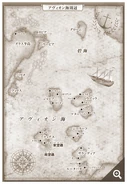There is a problem with parsing the infobox
|}</onlyinclude>
The Imperial Army (帝国陸軍 Teikoku Rikugun) is the main army used by the Empire. The Imperial Army is similar in appearance and structure of the real-world Roman Army of its mid Imperial period, being made up primarily of formations of heavy infantry armed with spears, swords, large rectangular shields, and utilizing Roman testudo formations in battles. Also present in the military are cavalry, archers, siege engines such a battering rams, ballistae, and trebuchets, and dragon riders. Auxiliary forces are provided by both human and goblin vassal and clientele states of the Empire.
Overview[]
While the Empire is very Roman-like, their technology level is particularly more late-medieval. For instance the Imperial cavalry, who are typically similar in appearance to medieval knights, clad in plate armor and armed with swords and lances. Other medieval weaponry used by the Empire include halberds and trebuchets.
Since all the events in Gate have taken place on land, there has been no direct contact with the Imperial Navy. A map of the Special Region depicts a Greco-Roman-style warship or trireme like in the classic ancient period, a mixed oar and sail powered vessel armed with a forward naval ram. This suggests the Empire or their vassal states possess some form of naval forces. It is later revealed that Imperial Navy is equivalent to the ancient Roman style warship in term of combat style, which involves ramming ship into enemy ship at fast speed or firing rain of arrows from one ship to another ship.
Despite their inferior and primitive weaponry, they still pose some threats to the JSDF, especially in large numbers when conducting ambush. In the Imperial Civil War, they manage to inflict some damages to the JSDF through human wave tactics and ambushes. However, due to Zorzal's idiocy and lack of wise thinking, they often lose against the JSDF since they do not fully adapt to JSDF weaponry and tactics based on the fact that they never incorporate firearms into the army. Therefore, they only manage to win against the JSDF through short term attrition with massive casualties until they are being utterly defeated by JSDF's superior weaponry.
During the event of Gate Season 2: Jieitai Kano Umi nite, Kaku Tatakaeri, it is revealed the Empire has extremely under-developed Navy forces, which causes them to fail to reach far away continents to invade. This fact explains why the Avion Sea is untouched by the Empire for centuries.
See: Imperial Soldiers and Imperial Trooper
Structure[]
Much like the Roman army, 80 soldiers or ten contubernium each consists of 8 soldiers will form a century lead by a Centurion. Six centuries together make up a cohort lead by Primus Pilus (The First Five) followed by his superior Camp Prefect who in charge of the daily operation in the camp; 5 tribuni angusticlavii and 1 tribunus laticlavius who is also a future potential senator. Finally, ten cohorts will create the largest division of troops is referred to as a legion lead by the Legion Legatus (General) who are also the member of the Senate. Other divisions of the army are not known, and it is not clear how the size of an Imperial legion compares to that of a Roman legion in the Early-mid Imperial periode (3.000-6.000 man per Legion and 1.000-2.000 man auxiliaries) or the late Antiquity (1.000 man per comitatensis) (field army) or Limitanei (border guard army) with 500-1.000 man foederati (barbarian mercenaries) in both. Auxiliaries like Orcs, Goblin or Troll and orders of knights are separated like the buccellati (Knight-like, by roman generals paid heavy armored and mounted mercenaries) in the late Antiquity.
Recruitment into the Imperial Army is either done voluntarily or through conscription. The Imperial Army also employs mercenaries and slaves to bolster their forces. Much of the infantry is made of peasant citizens. As mentioned by the merchants, soldiers of the Imperial Army lack basic education such as simple mathematics, and are easily cheated during negotiations. The life of the common foot soldier is harsh and he is seen as an expendable source to be thrown into human wave attacks.
One difference from the ancient Roman Army is the fact that the Imperial Army does employ a kind of Air Force in the form of the Wyvern Corps. These are soldiers who are trained to ride wyverns (dragons with winged forearms). They are normally armed with lances and use the wyverns' ability to breathe fire to attack enemy troops on the ground. They are the ancient equivalent of ground-support aircraft as the helicopters and jets of the JSDF. They are also used for reconnaissance, patrols, and for intimidation. However, they prove to be vulnerable to modern-day anti-aircraft weaponry and severely outmatched against modern aircraft. They are completely wiped out at the end of the Imperial Civil War.
All Auxiliaries members are non-Empire citizen and are often treated as meat shield and cannon fodder for the main Imperial force. Due to the racism against humanoid, these Auxiliaries members cannot gain citizenship like in the real-life Auxiliaries soldiers (an Auxiliaries Roman soldier could gain citizenship after 35 years of services).
In the Imperial Palace, there are the elite group of soldiers called Imperial Guard who are in charge of protecting the Emperor, the royal family and the Senate. Despite their superior fighting power over normal soldier, they are still being outclassed by the Rose Order of Knights since Bozes and Beefeater can defeat several of them with ease.
Imperial Army Size[]
The exact number of soldiers of the entire Imperial Army is still unspecified. Although the size of the Empire is comparable to that of the real-world Mongol Empire, by the fact that the Imperial Army is more similar to the Roman Army of the real-world Rome Empire (in appearance and structure), it is presumed that the size of the Imperial Army is also similar to that of the Roman army during the Rome Empire, namely about 645,000 fighting forces (without putting the special operations forces).
However, after the end of the wars between the Empire and Japan (at the end of the Imperial Civil War more exactly), the Imperial Army suffered cataclysmic losses, losing 90% of the total Imperial Army, leaving the Imperial Army with only about 64500 active fighting forces.
This fact making the Empire enter in a period of an immense decline for at least an entire century and also making the Empire very vulnerable against any possible attacks that may come from other armies, nations or even other empires that may exist in the Special Region, depending now on Japan Self-Defense Forces for their protection until their full recovery.
Known Units[]
Infantry[]
- 1st Corps
- 6th Corps
- 7th Corps
- 9th Corps
- 10th Corps
- 11th Corps
- 13th Corps
- 15th Corps
Cavalry[]
- 6th Cavalry
- 7th Cavalry
- 9th Cavalry
[]
- Galley
- Greco-Roman warship
- Hellenistic-era warships
- Trireme
Special Operations Forces[]
- Armored Ogre (100% destroyed during the JSDF Blitzkrieg Offensive)
- Dragon Riders / Wyvern Corps (100% destroyed during the Imperial Civil War)
- Imperial Army Auxiliary Cohorts
- Demi-Human, Goblin, Humanoid, Orc
- Imperial Guard
- Oprichnina (100% destroyed or disbanded during the Imperial Civil War)
- Rose-Order of Knights (active)
- War Elephants
Culture[]
Unlike the JSDF and the general modern army's War is hell outlook, the Imperial army holds an outdated belief that War is glory along with extremely strong supremacist belief, which causes them to be extremely reckless in fighting the JSDF as they often charge head-on toward the line of fire of the JSDF without much of consideration of casualties. This attitude is reinforced heavily by the Oprichnina in the Imperial Civil War causing innumerably senseless massacres. They also suffer from 'fight the last war' syndrome in which they believe all present and future foes will fight in the same manner as all of their previous opponents. Therefore, the Empire is completely unprepared against foes like the JSDF, who utilize superior weapons and modern tactics, making the Empire's style of warfare ineffective and obsolete. The very idea of using snipers is abhorrent, causing officers and even Zorzal to fear for their lives.
The Imperial Army has a very firm attitude that numbers can win anything since they often won against their past enemies through sheer numbers. Therefore, one of the noticeable reason why the majority of Imperial military officials including Zorzal as well as the Oprichnina underestimate the JSDF as the JSDF often uses less than 500 troops including armored vehicles to attack Imperial army, Due to this backward thinking, the Imperial Army often wastes a lot of men fighting the small army of the JSDF, resulting in thousands of casualties of Imperial soldiers from rushing towards the firing line at point blank. Furthermore, despite stating that fighting the Imperial army is more like pest control, the JSDF still possesses far more caution to engage them and often tries to minimize casualties as much as possible because of their pragmatic conception in warfare. This result in the fact the JSDF always emerges victory with lowest number of casualties while the Empire not only loses the engagement but also suffers tremendous losses.
Before the arrival of the JSDF, mutiny is unheard of within the Imperial Army. However, after the arrival of the JSDF and during the Imperial Civil War, mutinies become prominent within the army due to the deployment of the Oprichiki to boost morale of the troops. Because of the Oprichnina's tendency to mindlessly push Imperial soldiers to their doom towards the JSDF's firearms as well as their disregards of the safety of Imperial officers and generals along with their simple-minded approach to warfare in suicidal frontal assault, there are lot of cases when Imperial soldiers and commanders mutiny against the Oprichnina's authority by either killing them or disobeying their mad orders. The prime examples are during the Siege of the Jade Palace, a centurion impaled an Oprichiki in the back as he kept pushing troops in front of the rain of arrows from the Rose Knights and killed retreating troops or some retreating soldiers stabbed dozens of Oprichikis members after realizing their encounter with Rose Knight had lost. Another example is at the end of the rescue operation of Matsui Fuyuki, centurion Borhos ignored Dulles's order to suicidal-pursue the escaping JSDF Special Force.
Because the idea of mutiny is still new to the Imperial Army, none of the Imperial officers have ever thought of killing off Zorzal and his goons, despite knowing fully well they pushed Imperial soldiers and officers to their pointless doom in their hopeless war against the JSDF.
Military Doctrine, Strategies, and Tactics[]
Doctrine[]
Similar to the real-world Roman Empire, the doctrine of the Empire is based around the concept of power projection. The Imperial Army is frequently deployed to conquer new lands, suppress rebellions, and maintain order within the country. The Empire also surrounds itself with a series of vassal states and other subjugate and buffer entities beyond its official borders.
Strategy[]
The main strategy of the Imperial Army is utilizing superior resources, manpower, organization to overwhelm and defeat the enemies. Although individual imperial soldiers may not be better than soldiers of neighbor countries, the soldiers were trained to memorize every step in battle, so discipline and order could not break down into chaos. Thanks to this, the Imperial Army can absorbs a lot of casualties without being routed which allows them to triumph over the opponents with fewer resources.
While this strategy worked well against the past enemies whom had a similar level of technology, it failed miserably in front of JSDF. Not only because Japan has more resources than the Empire, They also possesses an overwhelming firepower which is able to inflict enormous damages on the Imperial Army while minimize its own casualties.
Tactics[]
The main strategies of the Imperial Army include human wave maneuvers, frontal attacks, and close-quarters combat. Due to the primitive level of technology in comparison to modern Earth, the Empire relies on overwhelming the enemy by sheer force of numbers and brute force, similar to the tactics used by the Romans and Greeks of ancient Earth. Ranged weaponry is used to support the infantry but does not equal to the firearms and artillery of the JSDF. The main idea of open field warfare is to move large numbers of soldiers in formations and place them in a position to cut off and wear down the enemy on all sides. Outflanking and using pincer movements are to break down an opposing force. When besieging a fortified position, the Imperial Army relies on bombarding the enemy stronghold with catapults, trebuchets and the like to wear down and break the defensive walls and the defenders themselves, while using direct means such as battering rams, ladders and siege towers to overcome enemy positions.
In terms of defensive maneuvers, the Imperial Army employs the testudo formation. In this case, soldiers lock shields together to form a shield wall against arrows, spears and swords. This tactic offers no protection against small arms fire, artillery or explosives. To prevent an enemy army from advancing, they employ a Scorched Earth Tactic to deny them resources such as food, water and materials. However, this has the detrimental effect of weakening the Empire's citizens, making the lands uninhabitable, and ends in a loss of tax revenue. Furthermore, this tactic is virtually useless against a modern army like the JSDF, that has little to no need for the natural resources of the Empire.
All these tactics hinge on the assumption that the Empire will eventually overwhelm the enemy with sheer force of numbers. As such, there will always be casualties on both sides, though in the past, the Empire had always won these wars of attrition. However, once they find themselves up against the JSDF, the Empire fails to realize until it was too late that these tactics are far too costly and obsolete against the firepower and tactics of Japan. As a result, tactical retreat was not used until late in the Imperial Civil War, in which pro-war generals began to use this tactic after they lost far too many troops in failed ambushes. Resupply and communication lines are slow and primitive. Furthermore, every time the Imperial Army suffers huge losses in manpower and material, it can take months or even years to refill their ranks. After the Battle of Ginza and the First Battle of Alnus Hill, it took the Empire 2 months to raise the Allied Army. This however, led to the massive losses at the Second Battle of Alnus Hill.
Their attempts at using Guerrilla Warfare and the Scorched Earth also met with failure due to their commanders' stupidity and lack of understanding concerning the JSDF's weaponry and tactics even the principle of Guerrilla Warfare. In the end, the Imperial Army simply does not have any capability to defeat or even hold its own against a modern army with its current tactics and weapons. Basically, the majority of the Imperial Army is nothing more than cannon fodder. Due to the fact the Special Region is utterly stagnant in understanding science and technology, the Imperial Army as a whole failed to realize that technological advancement in weaponry can decide who will win or lose in the battlefield, causing them to never take into the account of studying JSDF weaponry. Only a few, such as Pina Co Lada, immediately realize the futility of using human wave attacks and close-quarters combat, when the enemy doesn't even have to be within the proximity of swords, arrows or catapults. A single F-4 Phantom II is more than sufficient to outmatch and decimate the Wyvern Corps. Using a lone AH-1S Cobra Attack Helicopter against a horde of poorly-armed bandits is considered as overkill. The might of the Imperial Army's infantry is virtually useless against tanks, mortars, artillery and small arms fire. As Shino Kuribayashi proved, a single soldier armed with an assault rifle and several clips of ammunition, is more than a match against a contubernium, armed only with swords, shields and spears.
Pina Co Lada's attempt to smuggle in a pistol to be reverse-engineered met with failure when the weapon was discovered and confiscated. However, it is very likely that plan was doomed to failure in any case, since the Special Region lacked the means to study the pistol, did not have the knowledge of how basic firearms worked, and did not have the industry and resources needed to reproduce the firearm and its ammunition, in a large enough scale to come close to rivaling the small arms of the JSDF.
Treatments of Prisoners of war[]
The Empire's normal method of treating prisoners usually involved dragging them behind a horse, and when the prisoners collapsed from exhaustion, they would be poked with spears or lashed with the flat of a blade, forcing them to rise and continue. Even if they did stand, however, they would still be brutalized with fists and feet. In this way, the prisoners would lose the will and strength to resist or flee, and it was also part of the process of breaking them before selling them as slaves.
On the other side, if Imperial soldiers and officers are taken as POWs by the enemy, the officers and nobles expect themselves to be treated as befitting to their rank since none of them experience the situation of being POWS before until their disastrous encounter with the JSDF, while the demi-human and common foot soldier are considered expendable. The Empire expects the high-ranking officers and nobles to be ransomed back or traded during negotiations. However, much to the shock of the Empire, Japan and the other countries of Earth, do not follow this practice nor keep slaves. All POWs are treated equally and fairly, much to the disgust of the nobles who were imprisoned alongside the demi-human and conscripted peasant soldiers.
History[]
Little is known about the pre-contact history of the Imperial Army, or indeed the Empire itself. It is known, however, that about 250 years prior to the events of Gate (mid-1700s Earth calender), the Imperial Army participated in a long and difficult conflict known as the Arctic War, presumably with some northern race or civilization. The contact presumably ended in an Imperial victory, with the Empire suffering severe losses.
Before their failed invasion of Japan, the last major action the Imperial Army took part in was the Empire-Warrior Bunny War under Zorzal El Caesar. This conflict was an unprovoked act of aggression that prompted by the need for slave labor in the Empire. The Empire was victorious, albeit with severe casualties. Zorzal ordered all of the Warrior Bunny tribes enslaved or slaughtered, and took their queen, Tyuule as his personal sex slave.
Ginza Incident[]

|
This article is a stub. You can help Gate - Thus the JSDF Fought There! Wiki by expanding it. |
In 20xx, (the year 686 of the imperial calendar) .
When the imperial army crossed the GATE into the other world, it appeared right in the middle of the Ginza district, in the city of Tokyo, Japan. Without provocation and seeing that there were no defenses in the area, the soldiers and demihumans began to attack the civilians and starting the battle of Ginza. As the initial battle lasted, they believed they had won too easily and turned their attention to the Japanese imperial palace with the purpose of taking it and looting it but the Tokyo police did their best to hold them back, just as they were going to break down the doors that protected the refugees, the self-defense forces arrived in the area and began to repel the invaders.
With the modern military technology of Japan, the JSDF managed to regain ground, the imperial soldiers, totally confused and frightened by the "magic" of those lands, began to take many casualties and were losing the support of the demihumans and the dragon riders.In the end the battle was lost for the empire and they were forced to return through the gate with all the soldiers who were not killed or captured along with a handful of slaves, resulting in Japanese victory and the start of the Japanese-Imperial War.
First and Second Battle of Alnus Hill[]

|
This article is a stub. You can help Gate - Thus the JSDF Fought There! Wiki by expanding it. |
After their defeat in Ginza, the empire has attempted to drive the JSDF back through the Gate, however they experienced a crushing defeat of the Imperial and Allied Army at the Second Battle of Alnus Hill, thanks to the far superior firepower of JSDF artillery, tanks, and machine guns. The battle resulted in the loss of over 60,000 Imperial soldiers, leading to a significant decline in Imperial military power and political influence.
Imperial Civil War[]
After Zorzal El Caesar's Coup, the Imperial Army suffers a loss of 90% of its overall remaining strength due to the idiotic tactics of Zorzal El Caesar and his commanding generals. Their use of mass human wave attacks, short-sighted guerrilla schemes, and ineffective countermeasures to Japan's technological might, quickly depleted the ranks of all remaining regiments and the Wyvern Corps itself was wiped out.
Pirate Attacks[]
Nearly 4 years after the Imperial Civil War, the weakened Empire begins to suffer attacks along its coastline by marauding pirates. Due to the resentment of the civilians over the massive losses, economic hardship, and devastation caused by the previous conflict, attempts to recruit and replenish the Imperial Army are futile and only the Rose-Order of Knights are recognized as an official branch. As such, the near-extinct Imperial Army cannot handle the pirates, thereby forcing Empress Pina Co Lada to ask for support from the stranded JSDF members.



































